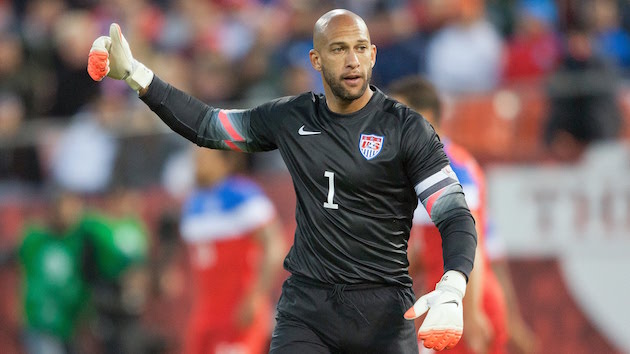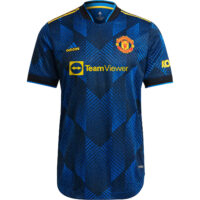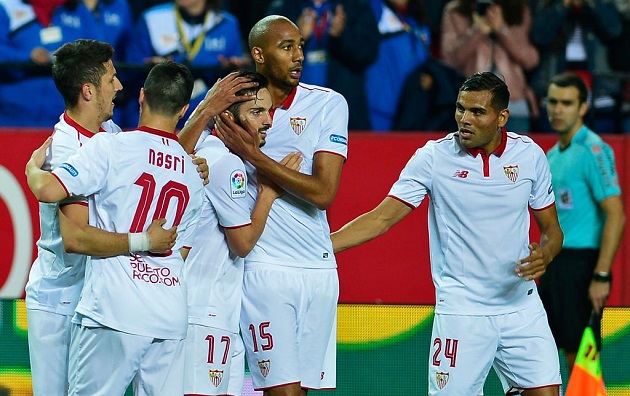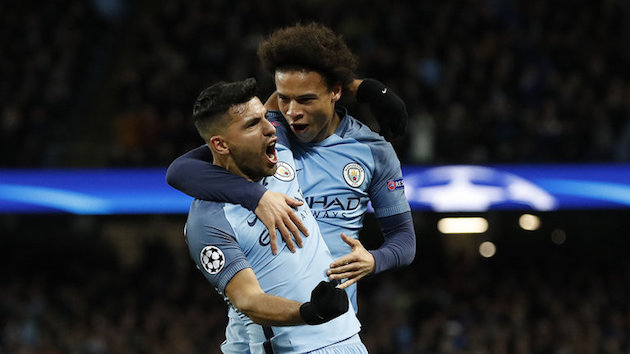Earlier this week, the United States celebrated the Fourth of July. That means fireworks and days off of work were commonplace across the country. But let’s focus on what really matters: soccer. In honor of the holiday, I’ve compiled my top XI for the U.S. National Team.
Goalkeeper: Tim Howard

There were plenty of excellent choices for the keeper. Casey Keller and Brad Friedel both performed admirably for the Stars and Stripes, but Tim Howard is who I’ve grown up with (and he’s a former Manchester United man). There were times that the new Colorado Rapids’ keeper looked completely impregnable between the pipes. Perhaps his best performance was during the 2014 World Cup against Belgium. Even though the U.S. lost the match, Howard made 16 saves. In his prime, the 37-year-old was a joy to watch, and he’s my first choice keeper.
Left back: Fabian Johnson
The first “foreign” player to join the list is Fabian Johnson (Abby Wambach please don’t hurt me). Johnson has only been a part of the U.S. setup since 2011, but in that time he’s shown what European experience can bring to the national team. During the 2014 World Cup in Brazil, Johnson was arguably the best player of the tournament for the US and even had some commentators saying he should be playing with the likes of Manchester United. Granted, his form and determination with the national team has been somewhat inconsistent in years past, but when he’s at 100 percent he is a force to be reckoned with on defense.
Right back: Steve Cherundolo
Steve Cherundolo was one of the first Americans to really establish themselves in Europe. For 15 years, the defender played for Hannover 96 and was even named the club’s captain near the end of his career. His leadership abilities, mixed with his lockdown defense made him a stalwart for the national team for more than a decade. He made more than 80 appearances for the Stars and Stripes during his 13-year national team career, and, in my opinion, he’s the best right back we’ve ever had.
Center back: Carlos Bocanegra
Cherundolo’s partner in crime was Carlos Bocanegra. Bocanegra was the first captain that I experienced as a fan of the Stars and Stripes. With more than 100 caps for the national side, the former Fulham defender represented the U.S. at two World Cups, and even captained the side during the historic victory over Spain at the 2009 Confederations Cup. Watching him play, you could always see why he was the captain. He always looked calm and composed at the back, and he always gave 100 percent no matter who the opponent was. That’s why he’s one of my two starting center backs.
Center back: Alexi Lalas
I’m not sure if Alexi Lalas is known better for his hair or for his play on the field. The FOX Soccer commentator was one of the first “star” players that U.S. Soccer ever had. In the 1994 World Cup in the U.S., Lalas played a pivotal role in our historic upset of Colombia at the Rose Bowl. His “interesting” hair choice made him easy to spot at the center of the U.S. defense and his relentless work ethic earned him a move to the Serie A after the 94 World Cup. It’s hard to find a better American over the ages that had the talent and drive that Lalas gave the national side.
Left midfield: DaMarcus Beasley
Near the end of his career with the national team, DaMarcus Beasley was transitioned into more of a left back than a left winger. The former PSV player was one of the quickest players on the pitch and provided the United States with an outlet for a counter attack. Over his illustrious career, Beasley has represented the United States in four World Cups (one of just three players to ever do that for the U.S.), and played a part in four different Gold Cup victories. His importance to the squad was very apparent for the 2015 Gold Cup, because Jürgen Klinsmann had to coax him out of retirement to be in the squad. Solid wide players have never come in abundance for the U.S., but I think that Beasley was one of the few great ones.
Center midfield: Claudio Reyna
Before Landon Donovan wore the number 10 for the national team, it was on Claudio Reyna’s back. Just like Beasley, Reyna represented the United States in three different World Cup tournaments, and was only the third American to be named to the all-tournament team during the 2002 tournament. He was a true leader on the pitch, and has even become an ambassador off of it. Over his 14-year career, Reyna played in the Bundesliga, Scottish Premier League and the English Premier League, and he also made 112 appearances for the Stars and Stripes.
Center midfield: Brian McBride
Lining up alongside Reyna in the heart of my midfield is going to be Saint Louis University alum Brian McBride. One trait that defined McBride’s legacy as a professional was his willingness to stick his head and body into any challenge. The lasting image, for me at least, from the 2006 World Cup in Germany for the U.S. had to be McBride’s bloody face after an elbow from an Italian player. His experience in the top leagues of European football made it seem as if he wasn’t intimidated by any team the U.S. went up against. Despite falling just five caps short of the 100 club, I still consider McBride one of the best midfielders that we’ve ever had at the international level.
Right midfield: Landon Donovan
Alright, I know I’m playing Donovan a little out of position but I had to slide him in somewhere. Granted, I wasn’t a big fan of his at the end of his career, but in his prime he was the most prolific striker the United States has seen. He had lightning pace and nose for goal that saw him score a record 57 goals for the Stars and Stripes. His most memorable goal was his last gasp strike against Algeria in South Africa to send the U.S. through to the knockout stages. Although his time in Europe was a little hit or miss, Donovan was always a reliable player for the national side. A couple of years ago, it’d be hard to find a U.S. jersey that didn’t have his number 10 on the back.
READ: Mexico and Back Again: Landon Donovan’s Best USMNT Goals
Striker: Clint Dempsey
Now for the man that is quickly catching up to Donovan’s goal-scoring record: Clint Dempsey. The 33-year-old currently sits on 52 goals, and shows few signs of slowing down. When I first started watching the national team play, I was always amazed at the amount of abuse that Dempsey took from the other side. What amazed me even more was the fact that he got up each and every time. In an era where flopping runs rampant in almost every single match, it was a refreshing thing to see. In addition to his toughness, the Texas native also brought a unique flair and finishing ability to the national side. Oh yeah, and let’s not forget about his rapping abilities either.
Striker: Jozy Altidore
Jozy Altidore is the biggest question mark for me in this group. He’s far from consistent and he has struggled with injuries throughout his career, but when he scores, he scores in bunches. He’s just 26, so there’s still plenty of time left for him to make his mark on the international stage. Through 93 caps, he’s found the back of the net 34 times (an average of a goal every 2.7 matches). With the U.S. usually unable to play a beautiful possession football, we’re usually forced to go to long balls into the box, and that’s where Altidore can succeed. His size and strength makes him a constant threat in the box. If he can stay healthy, he may soon be competing with Dempsey and Donovan for the goal scoring record.





No Comments